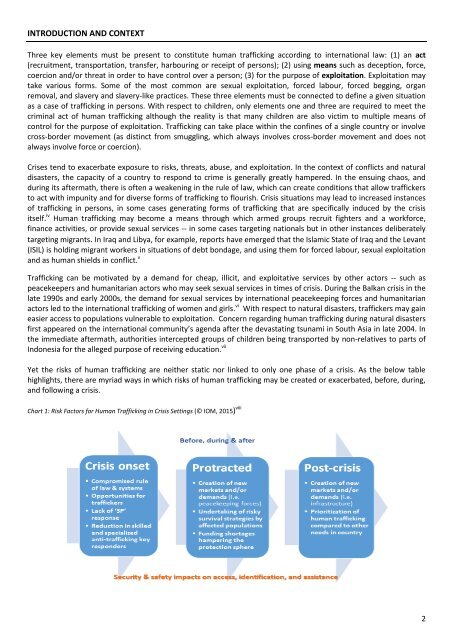Issue Brief
Trafficking%20Issue%20Brief%20final
Trafficking%20Issue%20Brief%20final
You also want an ePaper? Increase the reach of your titles
YUMPU automatically turns print PDFs into web optimized ePapers that Google loves.
INTRODUCTION AND CONTEXT<br />
Three key elements must be present to constitute human trafficking according to international law: (1) an act<br />
(recruitment, transportation, transfer, harbouring or receipt of persons); (2) using means such as deception, force,<br />
coercion and/or threat in order to have control over a person; (3) for the purpose of exploitation. Exploitation may<br />
take various forms. Some of the most common are sexual exploitation, forced labour, forced begging, organ<br />
removal, and slavery and slavery-like practices. These three elements must be connected to define a given situation<br />
as a case of trafficking in persons. With respect to children, only elements one and three are required to meet the<br />
criminal act of human trafficking although the reality is that many children are also victim to multiple means of<br />
control for the purpose of exploitation. Trafficking can take place within the confines of a single country or involve<br />
cross-border movement (as distinct from smuggling, which always involves cross-border movement and does not<br />
always involve force or coercion).<br />
Crises tend to exacerbate exposure to risks, threats, abuse, and exploitation. In the context of conflicts and natural<br />
disasters, the capacity of a country to respond to crime is generally greatly hampered. In the ensuing chaos, and<br />
during its aftermath, there is often a weakening in the rule of law, which can create conditions that allow traffickers<br />
to act with impunity and for diverse forms of trafficking to flourish. Crisis situations may lead to increased instances<br />
of trafficking in persons, in some cases generating forms of trafficking that are specifically induced by the crisis<br />
itself. iv Human trafficking may become a means through which armed groups recruit fighters and a workforce,<br />
finance activities, or provide sexual services -- in some cases targeting nationals but in other instances deliberately<br />
targeting migrants. In Iraq and Libya, for example, reports have emerged that the Islamic State of Iraq and the Levant<br />
(ISIL) is holding migrant workers in situations of debt bondage, and using them for forced labour, sexual exploitation<br />
and as human shields in conflict. v<br />
Trafficking can be motivated by a demand for cheap, illicit, and exploitative services by other actors -- such as<br />
peacekeepers and humanitarian actors who may seek sexual services in times of crisis. During the Balkan crisis in the<br />
late 1990s and early 2000s, the demand for sexual services by international peacekeeping forces and humanitarian<br />
actors led to the international trafficking of women and girls. vi With respect to natural disasters, traffickers may gain<br />
easier access to populations vulnerable to exploitation. Concern regarding human trafficking during natural disasters<br />
first appeared on the international community’s agenda after the devastating tsunami in South Asia in late 2004. In<br />
the immediate aftermath, authorities intercepted groups of children being transported by non-relatives to parts of<br />
Indonesia for the alleged purpose of receiving education. vii<br />
Yet the risks of human trafficking are neither static nor linked to only one phase of a crisis. As the below table<br />
highlights, there are myriad ways in which risks of human trafficking may be created or exacerbated, before, during,<br />
and following a crisis.<br />
Chart 1: Risk Factors for Human Trafficking in Crisis Settings (© IOM, 2015) viii<br />
2


